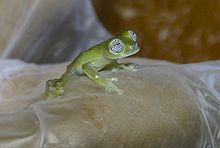| Sachatamia ilex | |
|---|---|

| |
| Conservation status | |
 Least Concern (IUCN 3.1) | |
| Scientific classification | |
| Domain: | Eukaryota |
| Kingdom: | Animalia |
| Phylum: | Chordata |
| Class: | Amphibia |
| Order: | Anura |
| Family: | Centrolenidae |
| Genus: | Sachatamia |
| Species: | S. ilex |
| Binomial name | |
| Sachatamia ilex (Savage, 1967) | |
| Synonyms | |
|
Centrolenella ilex Savage, 1967 | |
Sachatamia ilex is a species of frog in the family Centrolenidae. It is found in eastern Nicaragua, Costa Rica, Panama, western Colombia (Pacific lowlands and the Pacific slopes of the Cordillera Occidental), and western Ecuador. The common name Limon giant glass frog has been coined for this species, apparently in reference to its type locality in the canton of Limón, Costa Rica, and it is also known as Holly's glassfrog and the ghost glass frog.
Description
Adult males measure 27–29 mm (1.1–1.1 in) and females 28–34 mm (1.1–1.3 in) in snout–vent length. The snout is truncate in lateral view. Both fingers and toes have webbing and there are adhesive discs on the tips of the digits. The dorsal skin is shagreen. The dorsum is uniform dark green in color while the gular region and belly are creamy white. The iris is white or light gray with black reticulations.
This frog is active at night. In the day it crouches on the upper side of a leaf, adjusting its colour to match the background. The males call from the upper surfaces of the leaves near streams and may engage in fights. The eggs are black and are deposited on the upper surface of the leaves, and when they hatch, the larvae fall into the water below.
Habitat and conservation
Its natural habitats are humid lowland and montane primary and secondary forests at elevations between 180 and 1,430 m (590 and 4,690 ft) above sea level. It is typically found within the splash zone of waterfalls and torrents, and in bushes and trees alongside forest streams, which is where it breeds. While habitat loss is a localized threat, it is not considered threatened as a species by the International Union for Conservation of Nature (IUCN).
References
- ^ IUCN SSC Amphibian Specialist Group (2020). "Sachatamia ilex". IUCN Red List of Threatened Species. 2020: e.T54920A3021199. doi:10.2305/IUCN.UK.2020-2.RLTS.T54920A3021199.en. Retrieved 15 November 2021.
- ^ Frost, Darrel R. (2017). "Sachatamia ilex (Savage, 1967)". Amphibian Species of the World: an Online Reference. Version 6.0. American Museum of Natural History. Retrieved 30 April 2017.
- ^ Guayasamin, J. M.; et al. (2012–2017). "Sachatamia ilex". Ron, S. R., Guayasamin, J. M., Yanez-Muñoz, M. H., Merino-Viteri, A., Ortiz, D. A. and Nicolalde, D. A. 2016. AmphibiaWebEcuador. Version 2016.0. Museo de Zoología, Pontificia Universidad Católica del Ecuador (QCAZ). Retrieved 30 April 2017.
- Acosta Galvis, A. R.; D. Cuentas (2017). "Sachatamia ilex (Savage, 1967)". Lista de los Anfibios de Colombia V.07.2017.0. www.batrachia.com. Retrieved 30 April 2017.
- ^ Halliday, Tim (2016). The Book of Frogs: A Life-Size Guide to Six Hundred Species from Around the World. University of Chicago Press. p. 271. ISBN 978-0-226-18465-4.
- Guayasamin, Juan M.; Bustamante, Martin R.; Almeida-Reinoso, Diego; Funk, W. Chris (2006). "Glass frogs (Centrolenidae) of Yanayacu Biological Station, Ecuador, with the description of a new species and comments on centrolenid systematics". Zoological Journal of the Linnean Society. 147 (4): 489–513. doi:10.1111/j.1096-3642.2006.00223.x.
| Taxon identifiers | |
|---|---|
| Sachatamia ilex | |
| Centrolenella ilex | |